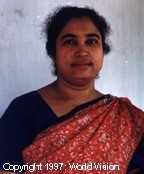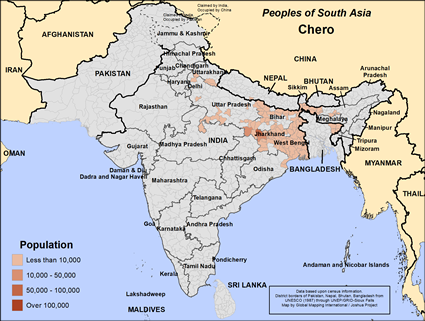The Chero were once the lords of the provinces surrounding the sacred Ganges River. They had a kingdom between the eighth and thirteenth centuries. The Chero people claim to be descendants of the Rajputs, a powerful caste of warriors and kings. Other sources say that Rajputs and the British East India Company displaced them. Some view them as either a scheduled tribe or a scheduled caste. The latter would mean far lower status among Hindu communities.
Indian Chero people live in Bihar, Odisha, Uttar Pradesh, and West Bengal. Most live in Palamau, Shahabad, Champaran, and other surrounding districts. There is also a smaller Chero community in Bangladesh.
Most of the Chero live in villages near streams to ensure a fresh water supply. The villagers get timber from the forests to build their homes and to use as fuel. Their settlements are clusters of homes. The poorest Chero people live in mud homes.
Agriculture is vital to the Chero economy. Some hold land grants while others are not so fortunate. Men and women work together to produce the harvest, and the women love to sing as they work. Livestock is crucial for the livelihood of those living on the plains. Oxen, buffalo and cattle help them work the fields. Goats, fish and fowl are important components of their diet.
Other Chero people work as shopkeepers or petty traders in towns and cities. Those with fewer means might be coal miners or road workers. Some hold meager jobs in the cities or live near the foothills.
The Chero community identifies as Rajput, and they wear Rajput caste symbols. They do not have social interactions with those of lower castes. They strictly forbid marriage outside their community, even between their two subgroups. Other Hindu communities seem to offer them respect and Rajput status. Brahmin priests serve at their weddings, something they would be reluctant to do for scheduled tribes.
The nuclear family, which comprises parents and unmarried children, is the basic building block of Chero society. While they hold their elders in high regard, they view old age as an ailment. Councils, called panchayats, govern the community. These are composed of village elders, the headman and the high priest.
The Chero people are Hindu, even those in Muslim Bangladesh. They also worship their own deities such as Sairi-ma, Ganwar Bhabhani and Dulha Deo. The Chero perform animal sacrifices as part of their religious rituals.
At the present time, there are only a few known Chero people who follow Christ. There are very few disciples among them. Prayer is the key to seeing the Chero reached with the gospel.
Pray that God will send culturally sensitive missionaries who will show them the way to the cross.
Pray for a Christ-ward movement to flourish among this people group in the 2020s.
Pray for the Chero people to be blessed with peace, joy and spiritual prosperity as they follow Jesus Christ.
Pray for their leaders to have dreams and visions that will open their hearts to Jesus Christ and his ambassadors.
Scripture Prayers for the Chero in India.
| Profile Source: Joshua Project |











